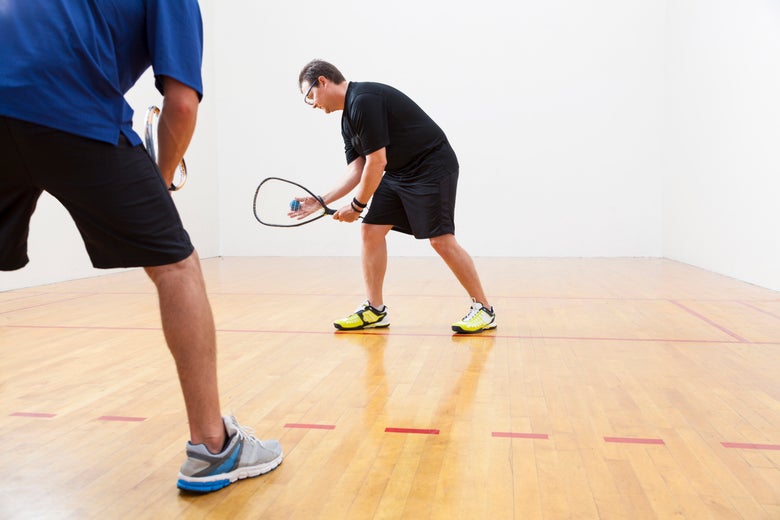Racquetball vs. Squash: What's the Difference?
Since Racquetball Warehouse has been open for over 20 years, we’ve received just about every question you can get related to racquetball. One the most popular beginner questions we receive is, “What’s the difference between racquetball and squash?” While at first racquetball and squash may seem the same, there are significant differences in terms of the court, equipment, rules, and gameplay. Follow along as we explain those differences and learn about each sport!
Racquetball Vs Squash: History & Objectives
Racquetball History & Objective
Racquetball is a fast-paced indoor sport that originated in the United States in the 1940s. It is played with a hollow rubber ball and a racquet. Players must also wear eye protection and oftentimes wear a glove on their racquet hand. Players can play singles, doubles or even three-player racquetball and must hit the ball against the front wall, with the goal of making it bounce twice before their opponent can return it.
Squash History & Objective
Squash is a racquet sport that dates back to the early 19th century in England. It is played with a small, hollow rubber ball and a racquet. Players must also wear eye protection and oftentimes wear a glove on their racquet hand. Like racquetball, players can play singles or with multiple players on teams and must hit the ball against the front wall, with the goal of making it bounce twice before their opponent can return it.
Not much difference so far, right? Next, we’ll dig into one of the more significant differences between racquetball and squash: Their court setups.
Racquetball Court Vs. Squash Court
Racquetball Court
Racquetball courts are larger than squash courts, measuring 20 feet (6.09m) wide, 40 feet (12.19m) long, and 20 feet (6.09m) high. The walls of a racquetball court are solid, with no "out-of-bounds" areas.
The court has various lines that correspond with game rules. Lines on the court include the service line, the short line, the receiving line and more. To learn more about how a racquetball court is set up and what the lines on the court floor mean, be sure to check out our guide on how to play racquetball.
Squash Court
Squash courts are smaller than racquetball courts, measuring 32 feet (9.75m) long, 21 feet (6.4m) wide, and 18 feet (5.64m) high. The walls of a squash court are also solid, but there are out-of-bounds areas above the tin, which is a metal strip that runs along the bottom of the front wall. The front wall also has a service line, but it is much higher than the service line in racquetball, at 6 feet and 6 inches from the floor. Besides these wall lines, there are also various floor lines that correspond with game rules such as the short line, half court line, and service box lines.
Probably the biggest difference between racquetball and squash courts is how ceilings are treated. In racquetball, you may hit the ball off of the ceiling whereas in squash, a ceiling shot is considered out of bounds and not legal.
Racquetball Equipment Vs. Squash Equipment
Another significant difference between racquetball and squash is the equipment used in each sport.
Racquetball Equipment
Racquetball requires a racquet, ball, eye protection, proper footwear and more. Players use a racquet that is typically made of lightweight materials such as graphite, aluminum or even carbon fiber. The racquet has a large head and a short handl.
Racquetball balls are extremely bouncy and can travel at speeds up to 160 mph! Because of a racquetball ball’s ability to travel this fast, players must wear safety glasses to protect their eyes from the ball and/or potential collisions with opponents. Proper footwear is required for playing racquetball to ensure that your feet have proper support and traction while running around on the court.
Squash Equipment
Squash players use a racquet that is typically heavier and smaller than a racquetball racquet. The strings on a squash racquet are also tighter, which allows players to control the ball better. Squash balls are smaller and denser than racquetball balls, and they don't bounce as much. Like racquetball players, squash players also wear non-marking shoes to avoid damaging the court.
Rules and Gameplay
There are key differences in the rules and gameplay of racquetball and squash. Each sport has its own set of extensive rules, so for our purposes, we’ll cover the basics.
Racquetball Rules and Gameplay
In racquetball, players can hit the ball on any number of walls before it bounces on the floor, and the ball can also hit the ceiling. The server must hit the ball to the front wall, and the receiver must let it bounce once before returning it. If the server wins the rally, they get a point and serve again. If the receiver wins the rally, they become the server and have an opportunity to score a point by winning the rally.
The first player to reach 15 points in a game wins. Matches are typically played as best-of-three or best-of-five games. The last game in a match is typically played to 11. Some players adjust the game scoring to play longer to 21 or shorter to 7. You do not need to win by two points in racquetball during a tied game on the final point.
Squash Rules and Gameplay
In squash, players must hit the ball to the front wall before it bounces on the floor, and the ball cannot hit the ceiling. The server must hit the ball above the service line and into the opposite quarter of the court. If the receiver wins the rally, they become the server. Squash matches are typically played as best-of-five games. The first player to reach 11 points wins the game, but if both players are tied at 10 points, then the winner must win by two.
Popularity
Racquetball and squash are both popular indoor sports, but their popularity varies depending on location and demographic.
Racquetball Popularity
Racquetball is most popular in North America, particularly in the United States, where it is one of the most played indoor sports. Racquetball has also gained popularity in Latin America and parts of Europe over the years.
Squash Popularity
Squash is popular in many parts of the world, particularly in the United Kingdom, Australia and Egypt. Squash also has a strong following in Canada and the United States.
Health Benefits
In conclusion, while racquetball and squash are both indoor racquet sports, they have significant differences in terms of objectives, courts, equipment, rules and gameplay. Both are extremely popular indoor sports that offer excellent health benefits, making them great options for cardiovascular exercise.
Needless to say, we prefer the excitement and strategy required in a competitive game of racquetball and encourage you to see for yourself why it has become one of the most popular racquet sports!
FAQ's
Is racquetball or squash easier for beginners to learn?
- Like any sport, racquetball and squash can be challenging for beginners. Thanks to resources such as our How to Play Racquetball guide, you can get up to speed quickly and feel confident stepping on the court to start practicing and or play your first game!
Do I need to be in good shape to play racquetball?
- Both sports require a certain level of fitness since they are high-intensity cardio activities. However, players of all fitness levels can enjoy these sports. The more you practice, the more your skills will improve and likely you’ll notice a variety of physical and mental benefits thanks to this fun sport.
Can I use a racquetball racquet to play squash or vice versa?
- It's not recommended to use a racquetball racquet to play squash because the racquet and ball are designed differently for each sport. To learn everything you need to know about racquetball racquets, be sure to visit our racquetball racquet buying guide.
Can I play racquetball or squash alone?
- Yes, you can practice your skills and technique by practicing shots alone but the sport is played competitively with another person or in a group.


